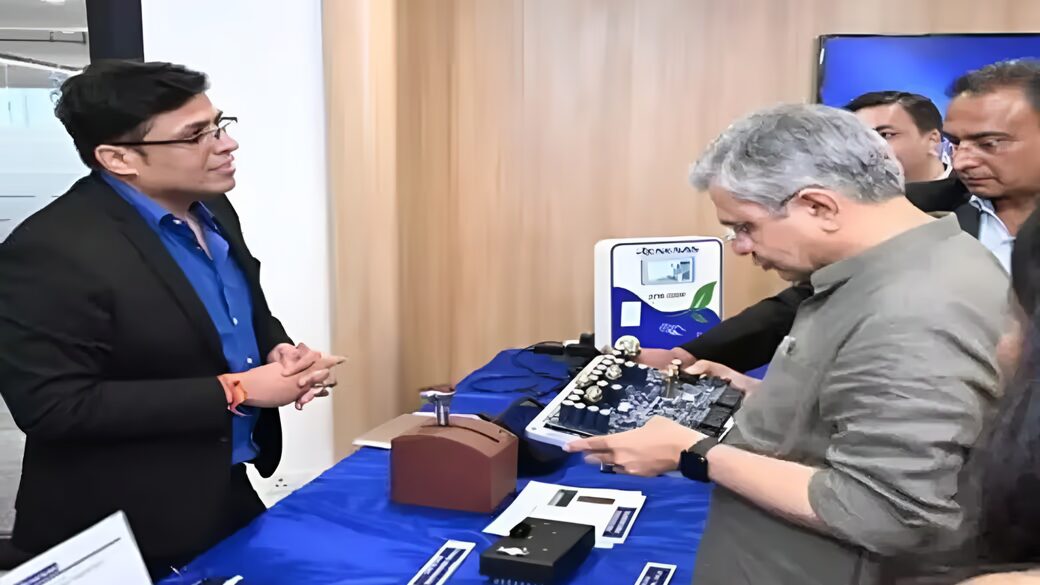
India is witnessing a historic leap in its technological journey with the inauguration of its first-ever 3nm semiconductor design hubs in Noida and Bengaluru. These centres are more than just buildings with advanced machines—they represent India’s growing ambition to be a global powerhouse in semiconductor innovation. For a country that has long been a consumer of technology, this is a defining moment in becoming a creator of cutting-edge tech.
Breaking New Ground in Chip Design–
On May 14, 2025, Union Minister for Electronics and IT Ashwini Vaishnaw officially launched these state-of-the-art facilities under Renesas Electronics India Private Ltd., a subsidiary of the Japanese semiconductor giant Renesas Electronics. These are India’s first centres to start designing 3nm chips, the most advanced and efficient semiconductor nodes currently in existence. Until now, such high-end design capabilities were limited to countries like the United States, South Korea and Taiwan.
Designing at the 3nm node means we’re talking about chips that are smaller, faster, and far more energy-efficient than previous generations. These chips are vital for next-gen technologies such as artificial intelligence (AI), machine learning (ML), 5G communications, advanced automotive systems, and even quantum computing applications.
ALSO READ- Bharat Bodh Kendra: Reawakening the Spirit of India
Strategic Collaborations and Global Backing–
These hubs are part of a larger wave of investment and collaboration taking place in India’s semiconductor ecosystem. Japan’s Renesas isn’t the only global player showing confidence. AMD recently opened its largest design centre globally in Bengaluru, with a massive capacity for 3,000 engineers across 500,000 square feet of high-tech workspace. This centre will play a key role in R&D for technologies such as AI and chip stacking.
Meanwhile, NXP Semiconductors, a major Dutch chipmaker, committed over $1 billion to boost its R&D operations in India. Their focus? Cutting-edge areas like automotive electronics, cybersecurity and IoT connectivity—all powered by custom chipsets. (Business Standard, Nov 2024)
These investments aren’t just about corporate profits. They signal that India is no longer just a backend service provider—it’s becoming central to the semiconductor innovation supply chain.
The Government’s Role: Vision and Execution–

India’s semiconductor story wouldn’t be complete without talking about the government’s proactive policies. The Ministry of Electronics and Information Technology (MeitY) is steering a mission-driven approach through its Semiconductor Mission, backed by a $10 billion incentive package. This mission supports everything from chip fabrication units to design houses and training programmes.
Minister Vaishnaw emphasised that this isn’t just about importing machines or setting up labs—it’s about developing talent. Over the next decade, India plans to train 85,000 engineers in semiconductor technologies. Partnerships with over 113 universities are already underway to create industry-aligned courses, ensuring students graduate job-ready for this high-tech field.
Why 3nm Technology Matters–
To understand why this is a big deal, think of semiconductors as the “brains” behind almost every electronic device. A smaller node like 3nm allows for:
- More transistors per chip, increasing computing power
- Lower power consumption, essential for mobile devices and battery-powered systems
- Greater energy efficiency, reducing heat and enabling longer device lifespan
- Smaller physical size, allowing thinner, more compact devices
This means that 3nm chips can help run AI models faster on smartphones, enable longer battery life in wearables, and improve the real-time decision-making of autonomous cars.
Globally, only a few companies like TSMC, Samsung, and Intel have mastered this node. That India is now entering this space is nothing short of remarkable.
Impact Across Sectors–
The ripple effect of these design hubs will touch every major sector of India’s economy. Here’s how:
- Automotive: India’s booming electric vehicle (EV) market will need powerful yet efficient chips for everything from battery management to autonomous driving features.
- Healthcare: Advanced chips will improve diagnostic equipment, wearable health monitors, and AI-powered patient analytics.
- Telecom: As India rolls out 5G and prepares for 6G research, cutting-edge semiconductors will be the backbone of communication infrastructure.
- Defence & Aerospace: Indigenously designed chips can reduce dependency on imports for mission-critical systems.
Fuelling Startups and Innovation–
India’s startup ecosystem will likely be one of the biggest beneficiaries with domestic access to cutting-edge chip design, startups in robotics, AR/VR, space tech, and AI will be able to build and test their products faster and at lower cost.

Also, design hubs often encourage incubation units or startup accelerators around them. This can kick-start entire innovation districts, similar to what we’ve seen in Silicon Valley or Hsinchu Science Park in Taiwan.
Building the Talent Pipeline–
An often overlooked but crucial aspect of semiconductor growth is talent. India already has a robust IT and engineering workforce, but chip design and fabrication require niche skills. The government’s initiative to align academic syllabi with industry needs—including subjects like VLSI design, nanoelectronics and semiconductor physics—will ensure students are ready for the jobs of tomorrow.
Additionally, many companies are setting up internal academies and mentorship programmes to upskill existing professionals, which could help mid-career engineers transition into this lucrative field.
Looking Ahead: Challenges and Opportunities–
Of course, the road ahead isn’t without challenges. India still lacks full-scale fabrication (fab) units for advanced nodes like 3nm—though efforts are underway with proposals from firms like Tower Semiconductor, Vedanta-Foxconn and Micron. Infrastructure for reliable power, water and logistics—critical for chip production—must also scale.
But the momentum is undeniable. With global tech giants backing India and the government laying a strong foundation, the ecosystem is rapidly maturing.
Conclusion: India Steps into the Future–
The launch of India’s first 3nm semiconductor design hubs in Noida and Bengaluru is more than a technological achievement—it’s a strategic national milestone. It shows the world that India isn’t just aspiring to be part of the semiconductor value chain—it’s ready to lead in it.
These hubs will shape the future of Indian tech, empower startups, generate employment, and reduce import dependency. They signal the dawn of a new digital era where India doesn’t just use the technology—it designs and innovates it at the most advanced global standards.
